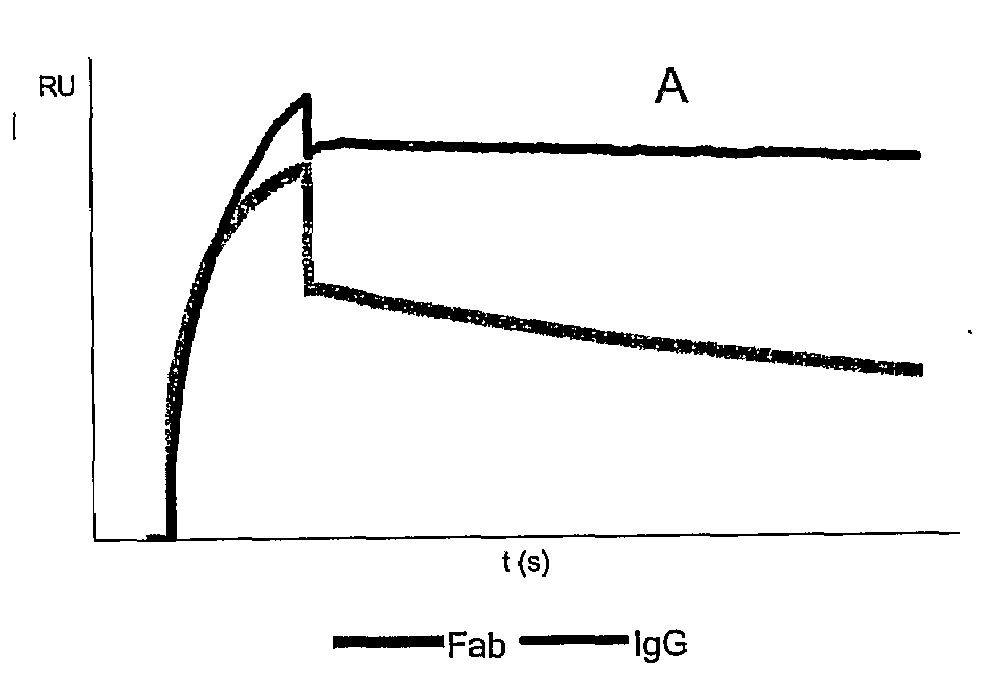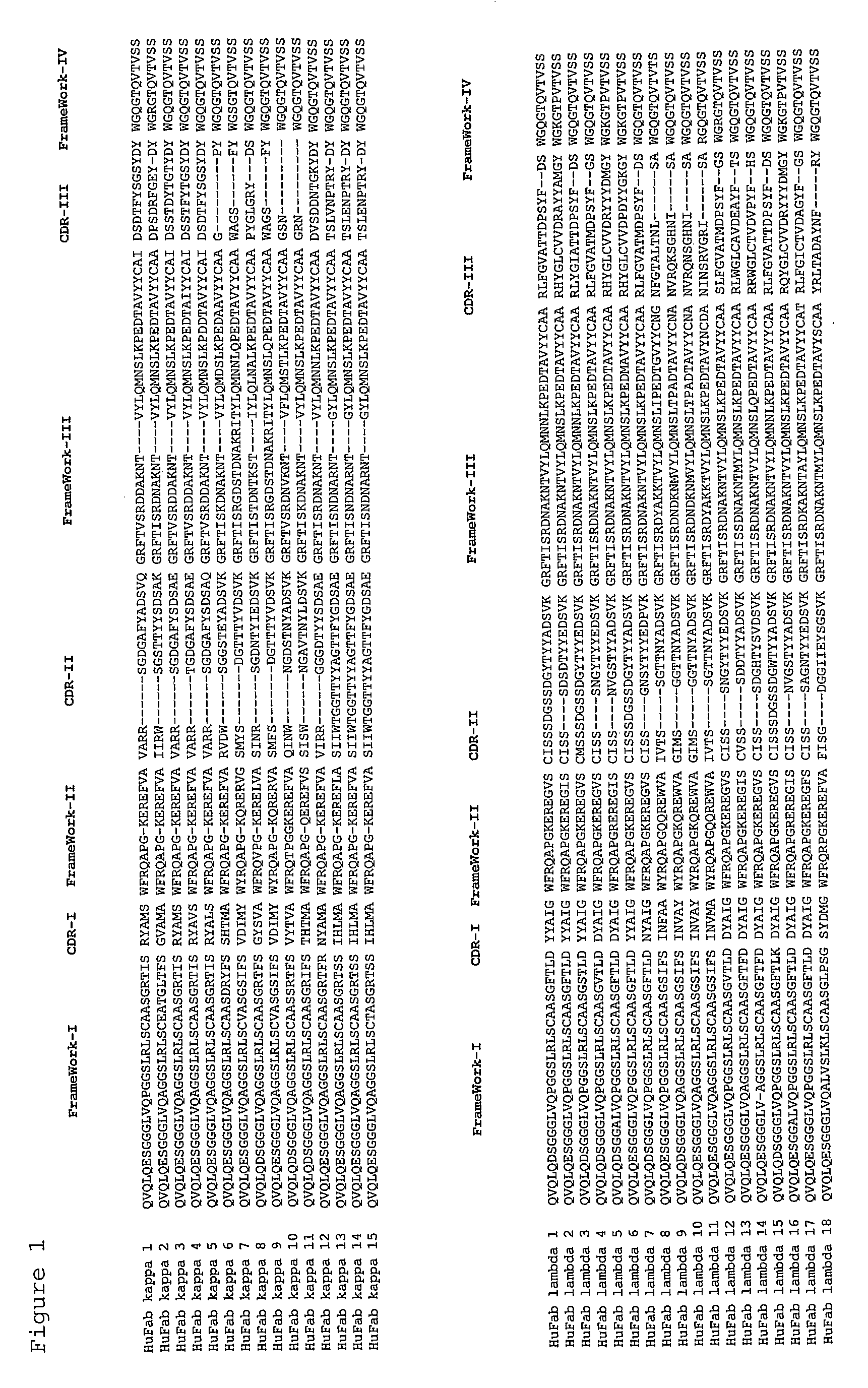Method For Affinity Purification
a technology of affinity purification and binding agent, which is applied in the field of affinity purification and to a binding agent, can solve the problems of loss of protein purification yield, unfavorable stringent elution conditions, and leakage of target material in the eluent, and achieve the effect of high capacity of the column
- Summary
- Abstract
- Description
- Claims
- Application Information
AI Technical Summary
Benefits of technology
Problems solved by technology
Method used
Image
Examples
example 1
Generation of Llama VHH Ligands Against Kappa Light Chains of Human Antibodies
[0092]The following protocol is taken as an example of how specific VHH fragments can be isolated, cloned, expressed, then coupled onto the desired matrix.
[0093]Although the particular VHH fragments described in this example were derived from an immune repertoire, they also could have been selected from a non-immunized VHH library (see EP1051493, Unilever) or a synthetic / semi-synthetic non-immunized VHH library (see WO00 / 43507, Unilever).
[0094]A llama was immunized with polyclonal IgM prepared from human serum by precipitation and gel filtration techniques and diluted in phosphate buffered saline pH 7.4 (PBS). To increase the specificity of the immune response the llama was boosted several times following the initial immunization (days 0, 28 and 49) with 250 μg of the antigen mentioned above in specol (ID-DLO, Lelystad, The Netherlands) (Boersma et al., 1992). A heparin blood sample of about 150 ml was tak...
example 2
Affinity Measurements
[0099]Binding affinity constants of VHH fragments Hu-kappa-1, Hu-Fc-1 and Hu-Fc-2 were determined using surface plasmon resonance analysis (SPR) on a BiaCore 3000. For this purpose, purified VHH fragments were immobilised onto the surface of a CM5 sensor chip and subsequently incubated with different concentrations of human Fab and / or human IgG antibodies in HBS-EP buffer (0.01 M HEPES, pH7.4; 0.15 M NaCl; 3 mM EDTA; 0.005% Surfactant P20). Binding was allowed for 3 minutes at 30 μl / min followed by a dissociation step of 15 minutes at 30 μl / min. Binding curves were fitted according to a 1:1 Langmuir binding model using Biacore software. An overview of the calculated affinity data is given in Table 2. With regard to the anti Hu-kappa-1 fragment the effect of avidity is clearly demonstrated by major differences in dissociation rates between Fab—and IgG molecules. Since the anti Hu-kappa-1 fragment is immobilised onto the surface of a sensor chip, said surface can ...
example 3
General Materials and Methods for Coupling and Chromatography Testing
Coupling to N-hydroxysuccinimide (NHS) Activated Sepharose 4 Fast Flow
[0101]After purification the antibodies were dialysed to NHS coupling buffer. This buffer contains 0.1 M HEPES pH 8.3. For an optimal coupling efficiency the recommended ratio of volumes coupling solution / NHS sepharose is 0.5:1. The antibodies had different concentrations, 0.5-15 mg / ml, the ratio of antibody / NHS sepharose of the antibodies varied between 1:1 and 10:1. When a mixture of 2 ligands is immobilised onto the matrix a 1:1 ratio of ligands was used. The following procedure was used for coupling the antibodies to NHS activated sepharose 4 Fast Flow (General Electric Healthcare). Subsequently the matrix was washed twice with NHS coupling buffer. The NHS sepharose was mixed with the antibody solution and left overnight at 4° C. head over head or 1 hour at room temperature. After incubation the gel material was filtered over a sintered glass...
PUM
| Property | Measurement | Unit |
|---|---|---|
| Fraction | aaaaa | aaaaa |
| Fraction | aaaaa | aaaaa |
| Fraction | aaaaa | aaaaa |
Abstract
Description
Claims
Application Information
 Login to View More
Login to View More - R&D
- Intellectual Property
- Life Sciences
- Materials
- Tech Scout
- Unparalleled Data Quality
- Higher Quality Content
- 60% Fewer Hallucinations
Browse by: Latest US Patents, China's latest patents, Technical Efficacy Thesaurus, Application Domain, Technology Topic, Popular Technical Reports.
© 2025 PatSnap. All rights reserved.Legal|Privacy policy|Modern Slavery Act Transparency Statement|Sitemap|About US| Contact US: help@patsnap.com



